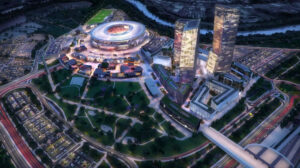Renowned architect Lev Libeskind delves into the transformative potential and unique challenges of converting office spaces into vibrant, community-centric residential areas
Originally interviewed by Kevinjonah Paguio and published by AZBIGMEDIA on May 30, 2024
As an architect and designer, what do you think of office-to-residential conversion projects? Are they feasible?
At Libeskind Studio Design, we view office-to-residential conversion projects as not only feasible but also as an unprecedented opportunity to transform communities. These initiatives allow developers and neighborhoods to breathe new life into existing structures, turning them into vibrant living spaces. A good example of this from the last century can be found in the many office buildings and even old factories and warehouses, throughout Manhattan and Brooklyn, which have been successfully converted into residential and now represent some of the most valuable real estate in New York City. Reflecting a sustainable approach to urban development, such projects repurpose existing resources instead of constructing ground-up, conserving materials and energy while preserving pieces of the urban fabric. By infusing these structures with new narratives, we are committed to engaging in solutions-driven design that addresses the unique challenges and opportunities of each project. We are very excited about the potential to create meaningful and lasting impacts on communities through our work.
Are some buildings better suited for office-to-residential conversions than others?
Certainly, not all buildings are equally suited for such conversions. The architectural character, structural integrity, and the original purpose of the building play significant roles. For example, buildings with flexible floor plans, adequate natural light, and strong structural bones are more conducive to conversion. Historical or landmark buildings, while challenging, offer a unique canvas to meld past and present, creating deeply meaningful residential spaces. Challenges such as limited natural light from office to residential conversion can be mitigated through mixed-use approaches, which can often enhance the space beyond its original intent. Creativity is key in adaptive reuse, where considering the unique potential of each space is essential.
Are conversion projects easier or harder from an architectural perspective?
From an architectural standpoint, conversion projects can be both challenging and rewarding. They require a deep understanding of the existing structure and a creative approach to redesigning spaces that were intended for entirely different uses. Navigating building codes, structural constraints, and the need for modern amenities while preserving the building’s character can be complex. However, these challenges often lead to innovative solutions and compelling architectural narratives. For ethical and environmental reasons, as architects, we’re generally against demolishing existing buildings. If possible, it’s always preferable to renovate and convert them—to keep a building from the past and adapt it for the needs of the present.
Have you done a conversion project of any kind?
Our portfolio includes many conversion projects, both public and private, encompassing historical as well as contemporary buildings. A good example of a conversion project that we recently published on our website (www.libeskind.it) is that of “The Emerald”, where we’re converting a 1960s mixed-use building into a hotel in the heart of Berlin, Germany. Currently, we are actively involved in a wide spectrum of office-to-residential and mixed-use conversion projects across various cities in Europe and the United States. These projects are not just about repurposing space; they are about redefining the essence of buildings to reflect new uses and meanings, resonant with their communities. This commitment to adaptive reuse reflects our broader architectural philosophy, where every project is an exploration of how spaces can evolve to meet the needs of today’s urban communities.
What are other ways vacant spaces can be repurposed beyond multifamily housing?
Beyond residential conversions, vacant spaces offer myriad possibilities for repurposing. At LSD, our first step is always community engagement, emphasizing the importance of understanding the needs of the communities we impact. This understanding allows us to tailor each project specifically, whether transforming spaces into cultural centers, community hubs, educational facilities, creative incubators, or mixed uses. Then, working with developers, a repurposing strategy offers an opportunity to foster community, support local economies, and enhance the cultural landscape of an area. The key is to envision and realize the potential of these spaces in serving the community and creating value for stakeholders, including residents, local governments, and environmental organizations, ensuring a broad and positive impact.


